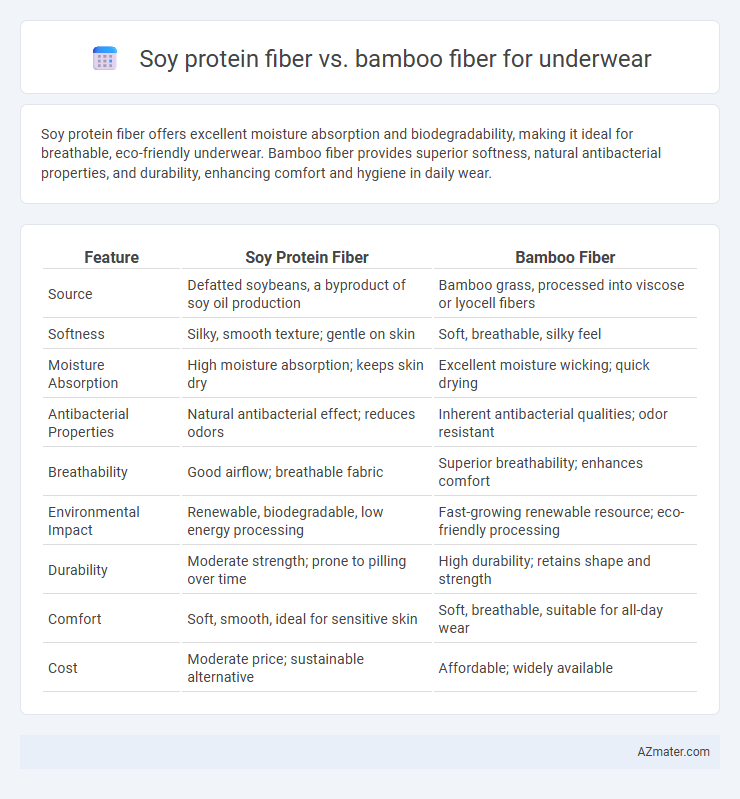Soy protein fiber offers excellent moisture absorption and biodegradability, making it ideal for breathable, eco-friendly underwear. Bamboo fiber provides superior softness, natural antibacterial properties, and durability, enhancing comfort and hygiene in daily wear.
Table of Comparison
| Feature | Soy Protein Fiber | Bamboo Fiber |
|---|---|---|
| Source | Defatted soybeans, a byproduct of soy oil production | Bamboo grass, processed into viscose or lyocell fibers |
| Softness | Silky, smooth texture; gentle on skin | Soft, breathable, silky feel |
| Moisture Absorption | High moisture absorption; keeps skin dry | Excellent moisture wicking; quick drying |
| Antibacterial Properties | Natural antibacterial effect; reduces odors | Inherent antibacterial qualities; odor resistant |
| Breathability | Good airflow; breathable fabric | Superior breathability; enhances comfort |
| Environmental Impact | Renewable, biodegradable, low energy processing | Fast-growing renewable resource; eco-friendly processing |
| Durability | Moderate strength; prone to pilling over time | High durability; retains shape and strength |
| Comfort | Soft, smooth, ideal for sensitive skin | Soft, breathable, suitable for all-day wear |
| Cost | Moderate price; sustainable alternative | Affordable; widely available |
Introduction to Soy Protein Fiber and Bamboo Fiber
Soy protein fiber, derived from natural soybean protein, offers breathable, moisture-wicking, and skin-friendly properties ideal for underwear fabric. Bamboo fiber, sourced from bamboo pulp, is renowned for its softness, antibacterial qualities, and excellent moisture absorption, enhancing comfort during wear. Both fibers provide sustainable alternatives to synthetic materials, promoting eco-friendly and comfortable underwear options.
Source and Production Process
Soy protein fiber originates from defatted soy flour, a byproduct of soybean oil extraction, undergoing a wet spinning process to transform soy proteins into a soft, biodegradable textile ideal for underwear. Bamboo fiber is derived from the pulp of bamboo plants through either mechanical crushing followed by natural enzyme retting or chemical processing involving solvents to produce a viscose-type fiber known for its breathability and antibacterial properties. The production of soy protein fiber emphasizes sustainability by utilizing agricultural waste, whereas bamboo fiber production varies in environmental impact depending on whether mechanical or chemical methods are used.
Environmental Impact Comparison
Soy protein fiber and bamboo fiber both offer eco-friendly alternatives for underwear, but differ significantly in environmental impact. Soy protein fiber, derived from soybean by-products, utilizes agricultural waste, reducing overall resource consumption and minimizing landfill waste. Bamboo fiber requires less water and pesticides compared to cotton cultivation, but its environmental benefits hinge on sustainable farming practices and chemical-free processing methods, making soy protein fiber generally more sustainable due to its reliance on repurposed materials and lower chemical input.
Comfort and Softness
Soy protein fiber offers exceptional softness and moisture-wicking properties, making it ideal for underwear that demands comfort and breathability. Bamboo fiber is naturally antibacterial, hypoallergenic, and highly absorbent, providing a silky smooth texture that enhances all-day comfort. Both fibers are sustainable, but soy protein fiber excels in stretchability while bamboo fiber stands out with superior odor control.
Moisture-Wicking and Breathability
Soy protein fiber exhibits excellent moisture-wicking properties due to its hydrophilic nature, effectively drawing sweat away from the skin to keep underwear dry and comfortable. Bamboo fiber is highly breathable and naturally porous, allowing superior air circulation that enhances ventilation and helps regulate temperature. Both fibers provide comfort for underwear, but bamboo's breathability gives it a slight edge in maintaining freshness during extended wear.
Durability and Longevity
Soy protein fiber offers moderate durability with natural softness and breathability, but it tends to weaken with frequent washing and prolonged wear. Bamboo fiber stands out for its high durability, maintaining strength and shape even after multiple washes due to its robust cellulose structure. Underwear made from bamboo fiber generally exhibits superior longevity compared to soy protein fiber, making it a more resilient choice for everyday use.
Skin Sensitivity and Hypoallergenic Properties
Soy protein fiber exhibits excellent hypoallergenic properties and is ideal for sensitive skin due to its smooth texture and natural protein composition that reduces irritation. Bamboo fiber also offers hypoallergenic benefits with natural antibacterial qualities, making it suitable for delicate skin and minimizing the risk of allergic reactions. Both fibers provide breathable comfort, but soy protein fiber's skin-friendly peptides promote enhanced moisture retention and gentle softness for users with heightened skin sensitivity.
Antibacterial and Odor Resistance
Soy protein fiber exhibits natural antibacterial properties due to its isoflavones, which inhibit bacterial growth and reduce odor accumulation in underwear, making it highly effective for prolonged freshness. Bamboo fiber contains natural antimicrobial agents like bamboo kun, providing strong odor resistance by preventing bacterial proliferation and moisture retention. Both fibers enhance underwear hygiene, but bamboo fiber often offers superior breathability and quicker drying, further reducing bacterial growth and odor formation.
Cost and Availability
Soy protein fiber offers an affordable alternative to traditional fabrics with moderate availability primarily sourced from agricultural byproducts, making it cost-effective but somewhat limited in widespread distribution. Bamboo fiber, derived from fast-growing bamboo plants, tends to have higher production costs due to its mechanical or chemical processing methods, yet it benefits from greater availability in global textile markets. Both fibers provide sustainable options for underwear, but soy protein fiber generally suits budget-conscious consumers, while bamboo fiber appeals to those willing to invest more for enhanced softness and moisture-wicking properties.
Conclusion: Which Fiber is Best for Underwear?
Soy protein fiber offers excellent moisture-wicking properties and a soft, silk-like texture, making it ideal for breathable and comfortable underwear. Bamboo fiber excels in natural antibacterial qualities and durability, providing odor resistance and long-lasting wear. For underwear, bamboo fiber is often considered the best choice due to its superior antimicrobial benefits and enhanced moisture management.

Infographic: Soy protein fiber vs Bamboo fiber for Underwear
 azmater.com
azmater.com